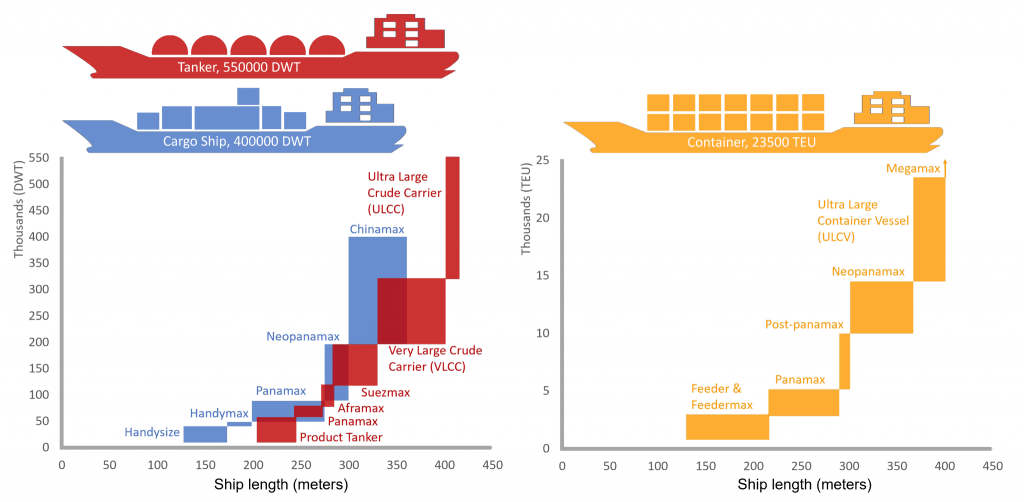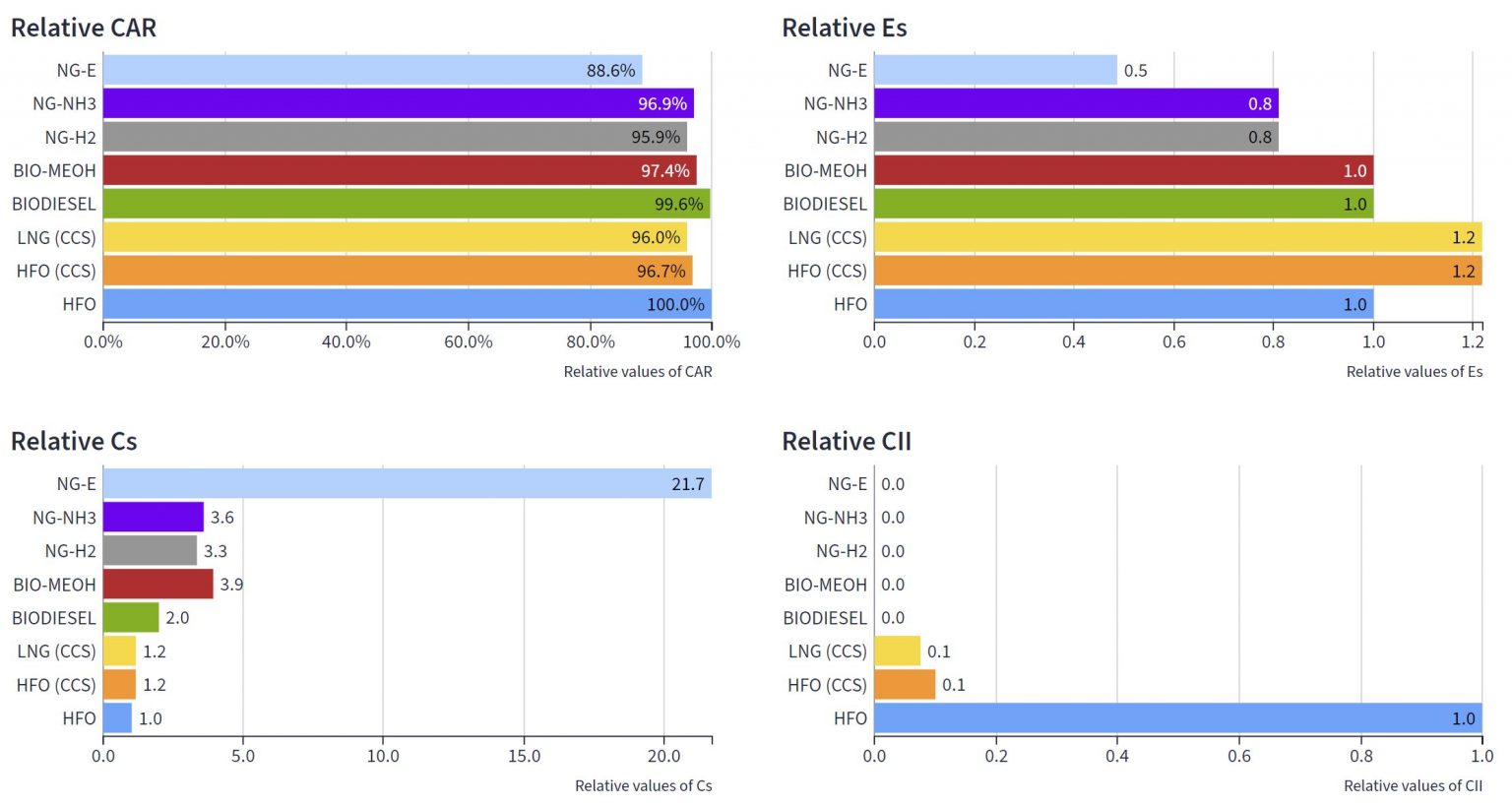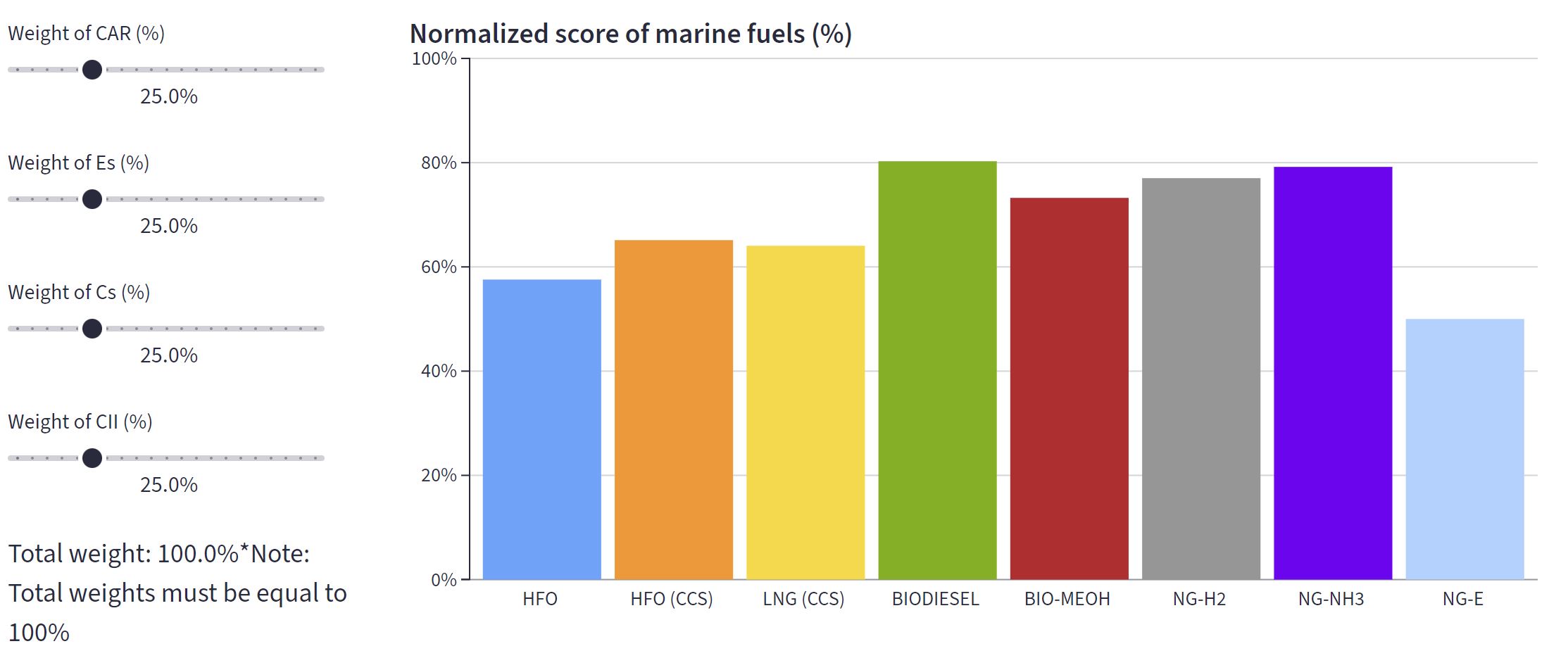There are four bar charts that present the relative CAR, Es, Cs, and CII for ships powered by different marine fuels. By default, the relative CAR for HFO-ship is 100% and the relative Es, Cs, and CII are equal to 1.
Home » Maritime Projects » Marine Fuel Comparison » About
ABOUT
MARINE FUEL COMPARISON
CALCULATOR
This calculator is a useful tool to visualise the difference in ship performance using alternative fuels compared to conventional HFO fuel. Ship performance is measured in terms of cargo attainment rate (CAR), specific energy (Es), specific cost (Cs), and carbon intensity indicator (CII); which are the ship performance indicators defined per unit of ship deadweight and ship voyage distance.
USER-DEFINED PARAMETERS
A total of 8 inputs need to be defined under “MY SHIP” user-defined parameters:
- Ship type, energy converter & max rated power (kW), and cargo type can be chosen from the drop-down list. Take note there are three options for energy converters which are internal combustion engine (ICE), electrical motor (EM) and fuel cell in combination with electrical motor (PEMFC & EM). Users can select a suitable energy converter with a power rating larger than their ship’s requirement and adjust the power setting (%) to obtain the average rated power of the ship.
- Ship deadweight capacity (tons or DWT), speed (knots), voyage distance/trip (n.m.), days of ship operation per year, and power setting (%) can be adjusted using a slider.
- “Click to Reset” will reset the parameters.
Three types of ships are included which are tanker, cargo ship and container. The figure below shows the ship length (meters) of various types of ships and their categories. Generally, tanker and cargo ship are categorised based on ship deadweight, whereas container is defined based on the ship cargo capacity in twenty-foot equivalent units (TEU).

From the statistics of ship capacity, the largest ship sizes in operation today are 550,000 DWT. Hence, users can drag the slider for deadweight to define the size of their ships.
From the statistics of ship speed, the voyage speed has been reduced to minimise carbon emissions. In this study, users can adjust the voyage speed between 5 – 25 knots. This input is important to determine the duration of the voyage and fuel tank sizing based on the fuel consumption rate. Please note that the voyage speed does not affect the power rating of the ship which is another user-defined parameter.
As derived from the AIS data, the majority of ships travel between 4,000 to 11,000 nautical miles (n.m.). The voyage length input is adjustable between 2,000 to 20,000 nautical miles. This input is required for the calculation of voyage duration based on the input of speed. A longer voyage distance consumes more energy and requires more marine fuel to be stored onboard.
This input is required for the calculation of total fuel consumption per annum. The default setting for this input is 280 days, considering the days when a ship is bunkering and not operational.
After defining the fuel type (Parameter 6), users need to select an energy converter for their ship. Please note that the value of rated power which is in unit kilowatt (kw) is the maximum power rating for the energy converter. There are three type of energy converters which are internal combustion engine (ICE), electrical motor (EM), and Proton-exchange Membrane fuel cell in combination with electrical motor (PEMFC & EM). The energy conversion efficiency for ICE, EM, PEMFC & EM are assumed equal to 45%, 92.5%, and 55.5% respectively. This assumption is made based on the data available in the literature and the efficiency of energy conversion could be increased with more research & development. Refer to the paper “A Comparison of Alternative Fuels for Shipping in Terms of Lifecycle Energy and Cost” for more details.
In general, ship is not operated with 100% load; hence, users can adjust the engine loading between 0-100%.
The quantity of cargoes that can be carried by a ship varies with the type of cargoes as they have varying densities and stowage factors. The figure below shows the general types of cargoes and their stowage factor in unit cubic meter per tons (m3/tons).

RESULTS OF ASSESSMENT (MARINE FUEL COMPARISON)

Cargo Attainment Rate (CAR) is a ship performance indicator which is defined as the percentage of cargo attainable by an alternative ship as compared to a reference ship which has 100% CAR by default. CAR can be the ratio of deadweight or volume of “MY SHIP” to “REFERENCE SHIP” depending on whether the reference ship is a weight-critical or volume-critical ship.
Explanation of the results obtained:
- CAR higher than 100%: The ship can carry more cargo than the HFO ship.
- CAR lower than 100%: The ship can carry less cargo than the HFO ship.
Specific Energy (Es) is a ship performance indicator that is measured in units kJ/t.nm. Es is defined as the total tank-to-wake (TTW) energy (kJ) consumed by a ship per unit of ship capacity (tons or dwt, t) and voyage distance (nautical mile, nm).
Explanation of the results obtained:
- Es higher than 1: The ship is more energy intensive than the HFO ship.
- Es lower than 1: The ship is more energy-saving than the HFO ship.
Specific Cost (Cs) is a ship performance indicator that is measured in units $/t.nm. Cs is defined as the total tank-to-wake (TTW) cost ($) incurred per unit of ship capacity (tons or dwt, t) and voyage distance (nautical mile, nm). The total TTW cost has included both CAPEX and OPEX costs for utilities, energy converter, storage tank, and cost of carbon capture.
Explanation of the results obtained:
- Cs higher than 1: The operation of the ship is more costly than the HFO ship.
- Cs lower than 1: The operation of the ship is cheaper than the HFO ship.
Carbon Intensity Index (CII) is a ship performance indicator which is measured in units gCO2/t.nm. CII is used globally as a carbon rating system for shipping, it is defined as the total tank-to-wake (TTW) CO2 emission (gCO2) released by a ship per unit of ship capacity (tons or dwt, t) and voyage distance (nautical mile, nm).
Explanation of the results obtained:
- CII higher than 1: The ship emits more carbon dioxide than the HFO ship.
- CII lower than 1: The ship emits less carbon dioxide than the HFO ship.
RESULTS OF ASSESSMENT (MARINE FUEL COMPARISON)
The selected fuels are ranked by using normalising values of CAR, Es, Cs, and CII as per the assigned weights (by default, the weights for CAR, Es, Cs, and CII are set as 25%). The weights are adjustable between 0% to 100%; however, the total weights of all performance indicators must be equal to 100%. The result is presented as a bar chart, the higher the normalised score, the higher the ranking of the fuel.


